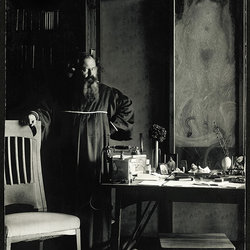Against Klimt
„Nuda Veritas“ and her Defender Hermann Bahr
Gustav Klimt’s celebrated but rarely shown painting „Nuda Veritas“ (1899) was left to the Austrian Theatre Museum by Hermann Bahr. “Naked Truth” - self-assured and in full frontal nudity – seems to challenge the viewer. The mirror in her hand expresses and emphasizes the painting’s meaning: artistic truthfulness without compromises as demanded by the artists of the Secession who elected Klimt as their first president. This is also the message of the lines from Friedrich Schiller’s “Xenien”: “KANNST DU NICHT ALLEN GEFALLEN DUCH DEINE THAT UND DEIN KUNSTWERK – MACH ES WENIGEN RECHT: VIELEN GEFALLEN IST SCHLIMM“ (if you cannot please everyone with your actions and your artwork – please only a few: to please many is bad“).
Hermann Bahr wrote and published much in support of the Secession. He countered the attacks on Klimt and his artworks - especially the latter’s paintings for the University of Vienna that caused such a scandal - with an essay entitled “Gegen Klimt” (“Against Klimt”), a collection of published vilifications of Klimt and his art, thus, Bahr felt, exposing their ridiculousness. In the autumn of 1900 he acquired “Nuda Veritas” from Klimt. The work also represents the controversial relationship between art, critics and the public. The blue serpent at the feet of true artistic expression stands for envy, its tail obstructing our ability to comprehend, or at least to recognize the truth.
How did Klimt devise this allegory? Which art-historical and literary traditions are combined in the various elements that make up this amazing image? The exhibition focuses on these questions and helps us to understand Klimt’s pictorial language. However, the show also documents the seminal role for the advent of Modernism played by the outrage, critical statements and the enthusiasm aroused by Vienna’s celebrated Avant-garde around 1900, and illustrates how these controversies continue to be relevant for today.








